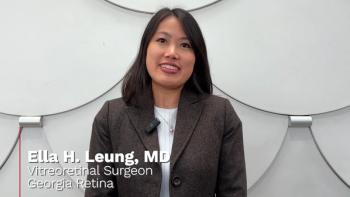
Electronic health records: Moving beyond 'just a requirement'
Cutting-edge solutions are emerging in healthcare that streamline data capture through a user-friendly interface, leading to an increase in quality and accuracy of data collection while freeing physicians to spend more time with patients.
Until recently, ophthalmologists have often viewed electronic health records (EHRs) as more of a burden than an essential tool for improving patient care and driving practice revenue.
However, that outlook is changing as cutting-edge solutions are emerging that streamline data capture through a user-friendly interface.
This has lead to an increase in quality and accuracy of data collection while freeing physicians to spend more time with patients.
Related:
Promoting compliance
Although there are many valuable features in these new solutions, one particularly important characteristic is a system’s ability to reliably promote compliance in real time.
The healthcare regulatory environment is constantly evolving, and physician practices may struggle to keep up with new developments. With this in mind, it is not unusual for providers to be behind the times regarding compliance nuances.
Given that, an EHR that incorporates regulatory changes and promotes compliance as the physician enters information into the patient chart can be a critical asset in helping practices limit regulatory shortfalls.
This kind of solution sends alerts in real time during the documentation process. These immediate cues allow the provider to address issues while still in the chart, serving more practical and time-saving than waiting until days or weeks later to resolve any discrepancies.
Related:
Improving efficiency
A user-friendly interface lets providers easily traverse the patient chart and reduces time spent documenting.
Going a step further, next-generation EHRs are starting to leverage predictive analytics to anticipate what data is needed based on the information the provider enters, as well as the patient’s health history.
The tool opens certain screens automatically, letting the provider quickly enter information without having to search for the right field or toggle between multiple locations.
Because these advanced solutions allow the provider quick access to relevant screens, the physician can focus less on the process of documenting and more on engaging with the patient to fully understand and resolve his or her health issues.
This improves both patient and physician satisfaction because the center of attention is on the patient — not the technology.
Related:
Enhancing data quality
Another benefit of a robust EHR is the quality of data that such a system cultivates. Prior to this, the amount of detail included in a patient’s record varied substantially depending on who was entering the information.
However, now, with solutions that prompt specific information, remind providers of missed details and offer dropdown menus that put key descriptors at the physicians’ fingertips, an organization can realize more consistent and precise data collection.
Detailed and comprehensive data also helps avoid denials or unnecessary payment delays that relate to documentation of medical necessity, thus speeding cash flow.
In addition, better data facilitates better data mining to spot concerning trends and identify improvement opportunities. This can be especially beneficial when organizations prepare to comply with value-based care initiatives.
As organizations seek to determine whether they are submitting the optimal quality measures or whether their costs are in line with those of others in the field, it is critical to have comprehensive data on which to draw. Without it, organizations can be limited in their abilities to effectively sift through information.
Related:
A key element in short- and long-term success
Having an advanced technology solution can also put an ophthalmology practice in a good position, should it want to seize a consolidation opportunity.
For the time being, ophthalmology practices will continue the consolidation trend seen this past year. those physicians who have an EHR that ensures efficiency, promotes accuracy and facilitates robust data collection — all while supporting a top-notch user experience — will be the most attractive partners.
While ophthalmologists may not have always appreciated EHR’s potential, the technology has advanced to the point where these solutions play a crucial role in enabling better patient care, stronger documentation and accurate reimbursement.
As providers continue to navigate the regulatory environment and begin to pursue value-based care models, they must embrace these automated tools; for they will be necessary moving forward to thrive in the evolving healthcare marketplace.
About the author
Dr. Handza is the chief medical officer for Nextech.
Newsletter
Don’t miss out—get Ophthalmology Times updates on the latest clinical advancements and expert interviews, straight to your inbox.













































